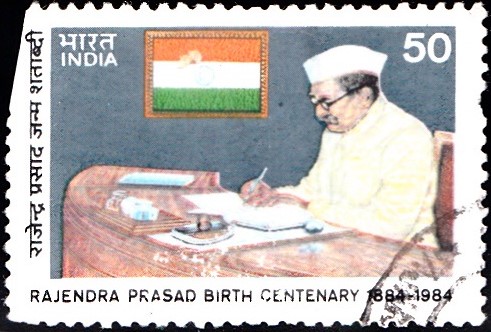
Rajendra Prasad 1984
A commemorative postage stamp on the Birth Centenary of Dr. Rajendra Prasad, 1st President of India (1950-62) : 
Issued by India
Issued on Dec 3, 1984
Issued for : The Posts and Telegraphs Department is proud to issue a commemorative stamp for the second time as an humble tribute on the first birth centenary of Dr. Rajendra Prasad, the first President of India.
Description of Design : The 50 p. multicolour stamp has been designed by India Security Press, Nasik. The First Day Cover shows Dr. Rajendra Prasad with Mahatma Gandhi. The cancellation design has been prepared by Nenu Bagga.
Type : Stamp, Postal Used
Colour : Multicolour
Denomination : 50 Paise
Overall size : 4.06 x 2.73 cms.
Printing size : 3.71 x 2.38 cms.
Perforation : 13 x 13
Paper : Unwatermarked P. G. matt coated paper
Number printed : 15,00,000
Number per issue sheet : 40
Printing process : Photogravure
Printed at : India Security Press
Name : Rajendra Prasad
Born on Dec 3, 1884 at Ziradei, Siwan district, Bihar, India
Died on Feb 28, 1963 at Patna, Bihar, India
About :
- Dr. Rajendra Prasad, the first President of the Republic of India was born on 3rd December, 1884 in a small village in the Saran district of North Bihar known as Jeradei. His father Mahadev Sahay was a scholar in Persian and Sanskrit.
- At the age of five, according to the practice of the times, Rajendra Prasad learnt Persian, besides Hindi and Arithmetic under a Maulvi. Later, he joined the Zilla school at Chapra from where he did his Entrance Examination at the age of 18, standing first in the first division. Thereafter, he joined the Presidency College, Calcutta for higher studies. He claimed the first position in B.A., M.A., LLB and M.L. Examinations. He was elected to the post of the Secretary of the College Union and started a student organisation whose members actively participated in Gandhiji‘s Champaran movement. It was in Calcutta as a student that Rajendra Prasad was exposed to a new awareness that had begun to dawn on the country at that time. The ‘Dawn Society‘ of which Rajendra Prasad was a member provided ample opportunities for his socio-political awakening.
- He first started legal practice in Calcutta. Simultaneously, he joined the Indian National Congress and was elected to AICC. Rajendra Prasad was really a diamond covered with dust. After 33 years, a clever jeweller who was no other than Mahatma Gandhi recognised his worth and presented him before the world, in 1917 when British atrocities ended in Champaran. He was a successful lawyer not merely by dint of his incisive intellect and phenomenal memory but also because of his innate honesty, integrity and purity of character. Jawaharlal Nehru once remarked that he was a symbol of the real India and “truth looked at you through his eyes“.
- Rajendra Prasad’s organising capacity, his devotion to service and popularity were fully appreciated by Gandhiji, specially after his role as Chairman of the “Bihar Central Relief Committee” formed to ameliorate the condition of thousands of people uprooted by the devastating earthquake which occurred in 1934, in Bihar. In 1920, Rajendra Prasad took the final plunge and dedicated himself wholly to the national cause, from where he did not look back. He joined Gandhiji’s Civil disobedience movement, non-cooperation movement and suffered several terms of rigorous imprisonment. Personally, he suffered severe privations for want of a regular income and had a weak health due to asthma, but they did not come in the way of his participation in the national struggle.
- Gandhiji persuaded him to become the President for the 48th Congress session held at Bombay in 1934. When in 1939, Subash Chander Bose resigned from the Presidentship of the Congress, Rajendra Prasad had to accept the responsibility again. In 1947, when Acharya Kripalani resigned as President of the Congress, all the leaders including Gandhiji unanimously requested Dr. Rajendra Prasad to accept the office. Thus he became President of the Congress for the third term. During the framing of the constitution Dr. Rajendra Prasad made momentous contribution as President of the Constituent Assembly. This was an event which had no parallel in the political history of India. This was an event even greater than his being the first President of India. His appointment to the high office of the President of India in 1950 came as a matter of course which he held lending great dignity to it. He held the office for two terms and retired in 1962. After retirement, he settled in Sadaqat Ashram, Patna and breathed his last on 28th February, 1963.


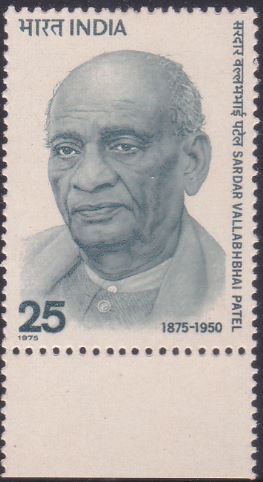
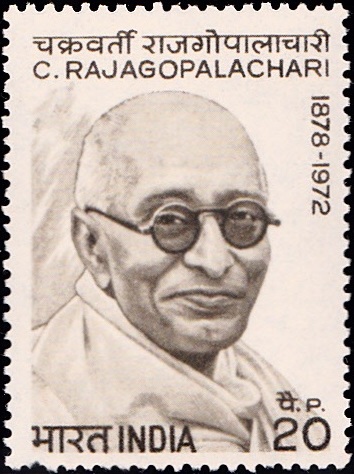
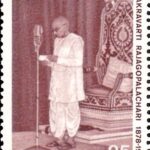
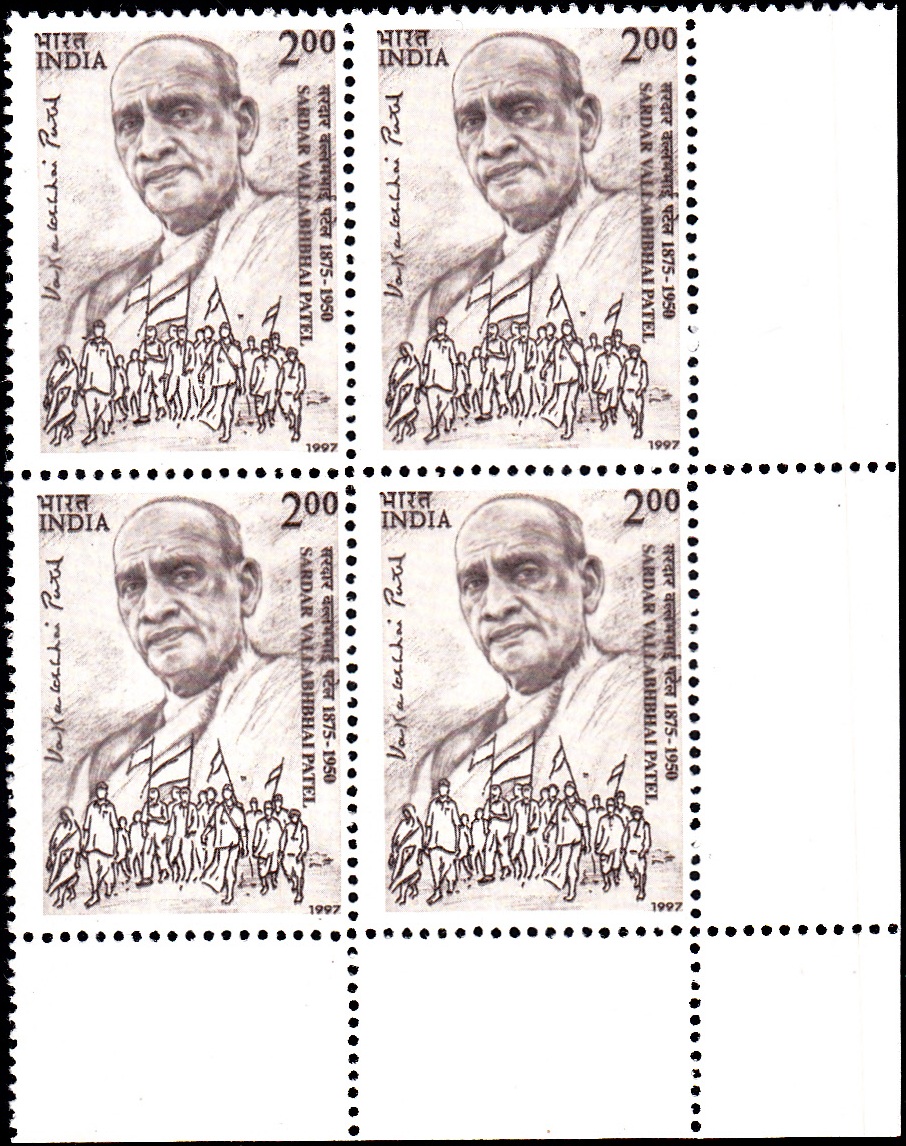
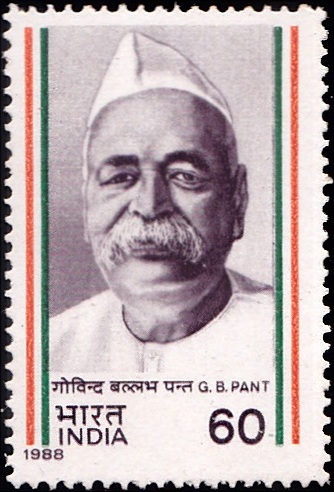
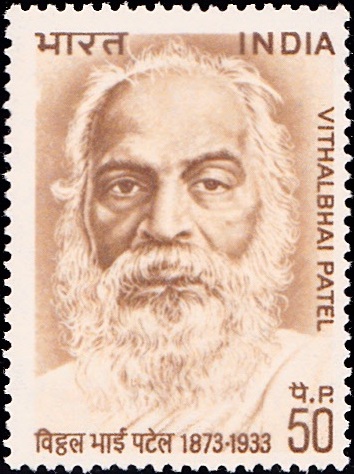
[…] current location in 1960 and the present building was inaugurated by the first President of India Dr. Rajendra Prasad on January 17th 1951. This college has the distinction of having Dr. B. R. Ambedkar as the Chairman […]
[…] Chand retired from the Army in 1956 with the rank of Major. The President of India conferred on him the award of Padma Bhushan in recognition of his outstanding services to the cause […]
[…] : The First Day Cover portrays Dr. Burgula Ramakrishna Rao with Dr. Rajendra Prasad, the first President of the Republic of […]
[…] the 4 Kumaon had the unique honour of being the first unit to be presented with new colours by Dr. Rajendra Prasad, the President of India, on 8th April, […]
[…] Dr. Rajendra Prasad presented the Presidential Trophy to SIXTY on 10 March 1955 in recognition of noble work done in Korean Campaign. […]
[…] 15th August, 1947, with India attaining Independence. In the words of country’s first President, Dr. Rajendra Prasad, at the Constituent Assembly, 11 p.m., 14th August, 1947 – In this Solemn hour of our history […]
[…] of the resolution was immediately followed by the arrest of Gandhiji, Panditji, Sardar Patel, Rajendra Babu, Maulana Azad and all other prominent leaders and the adoption of other stern measures by the […]
[…] because of his services in the Sind, which was mostly a desert. His ties with Sardar Patel and Dr. Rajendra Prasad were also very […]
[…] fighter and long serving legislator from Bihar. He is also remembered for his association with Dr. Rajendra Prasad, Pt. Jawahar Lal Nehru, and other senior leaders of his […]
[…] by Indian surveyors. It has also undertaken to acquire private papers of Indian luminaries like Dr. Rajendra Prasad, Maulana Abul Kalam Azad, Pandit Govind Ballabh Pant, Sarojini Naidu, etc. The varied nature of […]
[…] public funds. On more than one occasion great leaders of the nation like Pandit Jawaharlal Nehru, Dr. Rajindra Prasad, Sardar Vallabh Bhai Patel complimented him for his self-less service. He was the inspiration […]
[…] of the resolution was immediately followed by the arrest of Gandhiji, Panditji, Sardar Patel, Rajendra Babu, Maulana Azad and all other prominent leaders and the adoption of other stern measures by the […]
[…] Formerly the British Viceroy’s house, the building that stands at the heart of the modern Indian Republic became Government House on 15 August, 1947, when India gained Independence. It became the residence of Chakravarti Rajgopalachari, the first Indian Governor-General, on 21 June, 1948, when he was sworn in following the departure of Lord Louis Mountbatten, the last British Viceroy and first Governor-General of India. It was renamed Rashtrapati Bhavan on 26 June, 1950, after the assumption of office by the first President of India, Dr. Rajendra Prasad. […]
[…] in debates and discussions which attracted the attention of senior leaders like Jawaharlal Nehru, Dr. Rajendra Prasad, Dr. B.R. Ambedkar, […]
[…] brought under its ambit the next year. On 3rd and 4th February, 1959 the then President of India, Dr. Rajendra Prasad, had dedicated the first blast furnaces of Rourkela and Bhilai Steel Plants to the nation. These […]
[…] 1958, the St. Joseph’s School celebrated its Centenary. Dr. Rajendra Prasad, the first President of India attended the function. St. Joseph’s European High School was […]